Money and Other Rewards as Motivators for Employees: Pros and Cons
VerifiedAdded on 2023/06/15
|8
|2464
|164
AI Summary
This essay discusses the pros and cons of money and other factors such as paid holidays, bonus, employee discounts, paid vacation, company parties or recreations, discount coupons, as motivating factors for the employees. It also throws light on the range of advantages and disadvantages of monetary and non-monetary rewards.
Contribute Materials
Your contribution can guide someone’s learning journey. Share your
documents today.
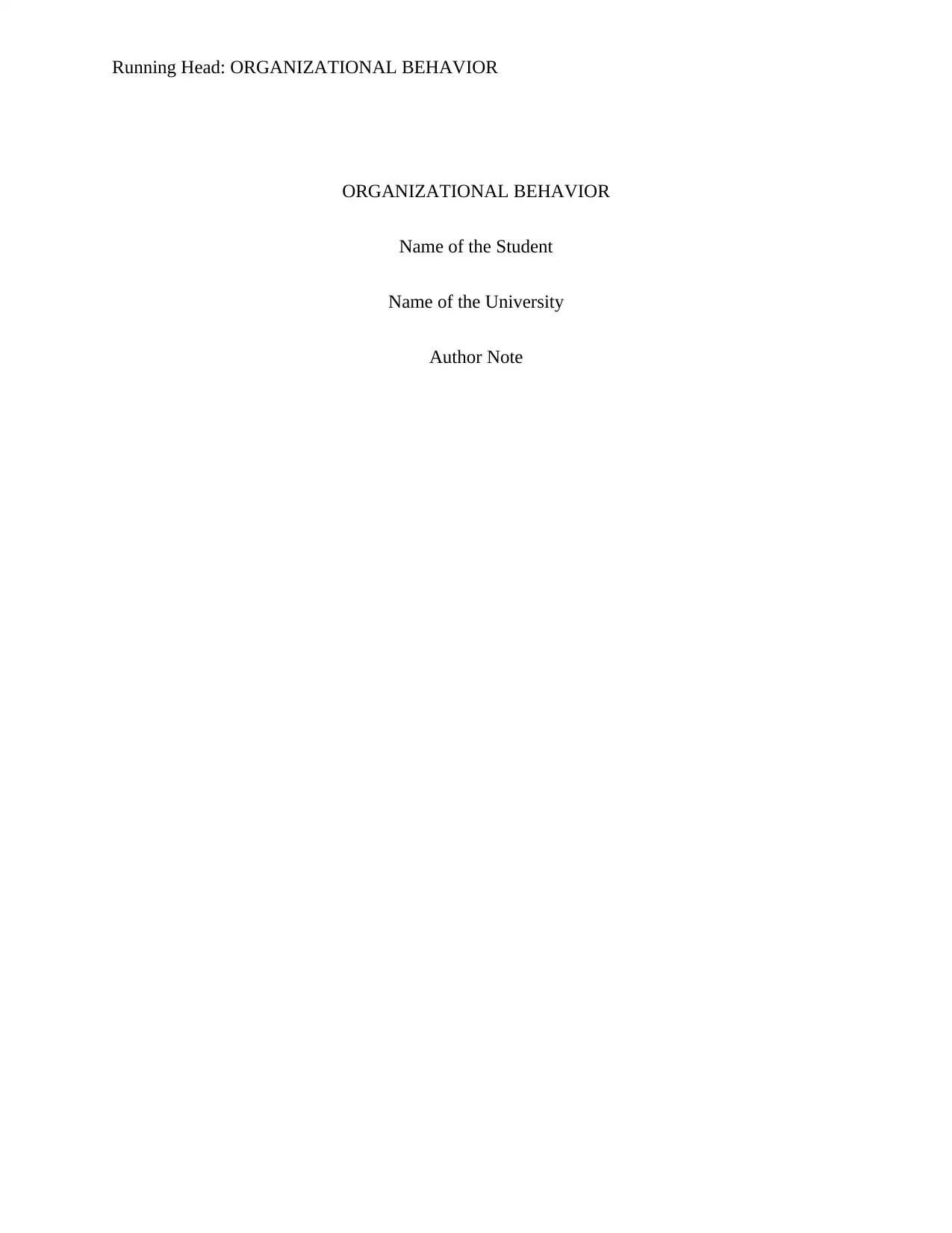
Running Head: ORGANIZATIONAL BEHAVIOR
ORGANIZATIONAL BEHAVIOR
Name of the Student
Name of the University
Author Note
ORGANIZATIONAL BEHAVIOR
Name of the Student
Name of the University
Author Note
Secure Best Marks with AI Grader
Need help grading? Try our AI Grader for instant feedback on your assignments.
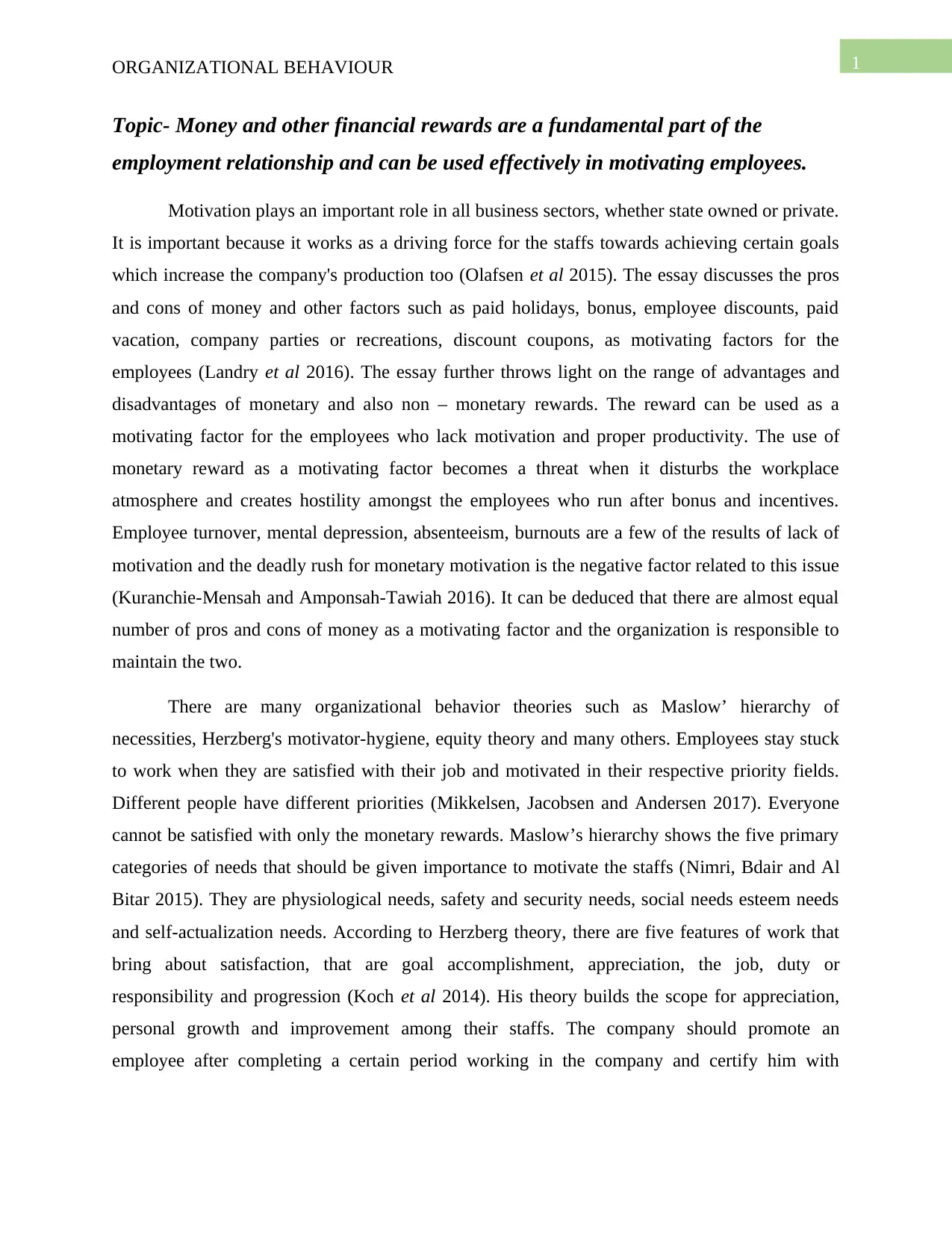
1ORGANIZATIONAL BEHAVIOUR
Topic- Money and other financial rewards are a fundamental part of the
employment relationship and can be used effectively in motivating employees.
Motivation plays an important role in all business sectors, whether state owned or private.
It is important because it works as a driving force for the staffs towards achieving certain goals
which increase the company's production too (Olafsen et al 2015). The essay discusses the pros
and cons of money and other factors such as paid holidays, bonus, employee discounts, paid
vacation, company parties or recreations, discount coupons, as motivating factors for the
employees (Landry et al 2016). The essay further throws light on the range of advantages and
disadvantages of monetary and also non – monetary rewards. The reward can be used as a
motivating factor for the employees who lack motivation and proper productivity. The use of
monetary reward as a motivating factor becomes a threat when it disturbs the workplace
atmosphere and creates hostility amongst the employees who run after bonus and incentives.
Employee turnover, mental depression, absenteeism, burnouts are a few of the results of lack of
motivation and the deadly rush for monetary motivation is the negative factor related to this issue
(Kuranchie-Mensah and Amponsah-Tawiah 2016). It can be deduced that there are almost equal
number of pros and cons of money as a motivating factor and the organization is responsible to
maintain the two.
There are many organizational behavior theories such as Maslow’ hierarchy of
necessities, Herzberg's motivator-hygiene, equity theory and many others. Employees stay stuck
to work when they are satisfied with their job and motivated in their respective priority fields.
Different people have different priorities (Mikkelsen, Jacobsen and Andersen 2017). Everyone
cannot be satisfied with only the monetary rewards. Maslow’s hierarchy shows the five primary
categories of needs that should be given importance to motivate the staffs (Nimri, Bdair and Al
Bitar 2015). They are physiological needs, safety and security needs, social needs esteem needs
and self-actualization needs. According to Herzberg theory, there are five features of work that
bring about satisfaction, that are goal accomplishment, appreciation, the job, duty or
responsibility and progression (Koch et al 2014). His theory builds the scope for appreciation,
personal growth and improvement among their staffs. The company should promote an
employee after completing a certain period working in the company and certify him with
Topic- Money and other financial rewards are a fundamental part of the
employment relationship and can be used effectively in motivating employees.
Motivation plays an important role in all business sectors, whether state owned or private.
It is important because it works as a driving force for the staffs towards achieving certain goals
which increase the company's production too (Olafsen et al 2015). The essay discusses the pros
and cons of money and other factors such as paid holidays, bonus, employee discounts, paid
vacation, company parties or recreations, discount coupons, as motivating factors for the
employees (Landry et al 2016). The essay further throws light on the range of advantages and
disadvantages of monetary and also non – monetary rewards. The reward can be used as a
motivating factor for the employees who lack motivation and proper productivity. The use of
monetary reward as a motivating factor becomes a threat when it disturbs the workplace
atmosphere and creates hostility amongst the employees who run after bonus and incentives.
Employee turnover, mental depression, absenteeism, burnouts are a few of the results of lack of
motivation and the deadly rush for monetary motivation is the negative factor related to this issue
(Kuranchie-Mensah and Amponsah-Tawiah 2016). It can be deduced that there are almost equal
number of pros and cons of money as a motivating factor and the organization is responsible to
maintain the two.
There are many organizational behavior theories such as Maslow’ hierarchy of
necessities, Herzberg's motivator-hygiene, equity theory and many others. Employees stay stuck
to work when they are satisfied with their job and motivated in their respective priority fields.
Different people have different priorities (Mikkelsen, Jacobsen and Andersen 2017). Everyone
cannot be satisfied with only the monetary rewards. Maslow’s hierarchy shows the five primary
categories of needs that should be given importance to motivate the staffs (Nimri, Bdair and Al
Bitar 2015). They are physiological needs, safety and security needs, social needs esteem needs
and self-actualization needs. According to Herzberg theory, there are five features of work that
bring about satisfaction, that are goal accomplishment, appreciation, the job, duty or
responsibility and progression (Koch et al 2014). His theory builds the scope for appreciation,
personal growth and improvement among their staffs. The company should promote an
employee after completing a certain period working in the company and certify him with

2ORGANIZATIONAL BEHAVIOUR
appreciation and recognition. The equity theory declares that the more an employee gets
rewarded, the more he gets satisfied with the input and efforts he/she has given to work.
There are few potential organisational problem situations such as employees who lack
motivations may tend to damage or interrupt the daily production of the organization. Culture-
shock, excessive workload, language problem, difficulty in team management, accommodation
and daily transport problems can affect their performance. Some employees who are engaged
with the company tools and machines on a daily basis and are supposed to maintain safety while
using them and need the most attention (Sari 2018). Hence, it is the responsibility of the
organization to maintain a steady workforce and behave sensitively regarding social, cultural,
and ethical issues. An organization should take care of the emotions of the employees to continue
the business smoothly. Lack of motivation and lack of job satisfaction may lead to absenteeism,
poor quality work, crude production, environmental and reputational risk, financial and health
risk and others.
Employees can get motivated by money through a far range of organization. The
American Compensation Association and the American Productivity Center conducted a survey
which proved that up to 99 percent of companies using money as a reward delivered the highest
production and resulted in being positive (Koch et al. 2014). If money is kept as the motivating
device in a particular organization, it can open various ways of using it. There are various ways
such as bonus, commission, pay, gift vouchers, foreign business trip rewards, which can initiate a
competition among the employees to achieve greater goals. Money appeals each employee,
irrespective of their designations. It appeals to a lower class worker and equally attracts a CEO
of a company. Therefore, another advantage of using money as a motivator is that it fascinates all
types of staffs. Since the ultimate aim of most of the people is to live a better life in the future
than today, employees strive to work hard to earn some extra dollars at the end of the month.
There are some apparent developments and specifications in organizational behavior
recently. In today's scenario of growing competition in the market, employers prefer non-
monetary or extrinsic rewards over intrinsic rewards because it is cost-effective and influential in
motivating the employees and recognizing new talent and high-calibre recruits (Nimri, Bdai and
Al Bitar 2015). Research has been conducted on the benefits of financial and non-financial
rewards, and it has been found that comparably those companies which focus more on non-
appreciation and recognition. The equity theory declares that the more an employee gets
rewarded, the more he gets satisfied with the input and efforts he/she has given to work.
There are few potential organisational problem situations such as employees who lack
motivations may tend to damage or interrupt the daily production of the organization. Culture-
shock, excessive workload, language problem, difficulty in team management, accommodation
and daily transport problems can affect their performance. Some employees who are engaged
with the company tools and machines on a daily basis and are supposed to maintain safety while
using them and need the most attention (Sari 2018). Hence, it is the responsibility of the
organization to maintain a steady workforce and behave sensitively regarding social, cultural,
and ethical issues. An organization should take care of the emotions of the employees to continue
the business smoothly. Lack of motivation and lack of job satisfaction may lead to absenteeism,
poor quality work, crude production, environmental and reputational risk, financial and health
risk and others.
Employees can get motivated by money through a far range of organization. The
American Compensation Association and the American Productivity Center conducted a survey
which proved that up to 99 percent of companies using money as a reward delivered the highest
production and resulted in being positive (Koch et al. 2014). If money is kept as the motivating
device in a particular organization, it can open various ways of using it. There are various ways
such as bonus, commission, pay, gift vouchers, foreign business trip rewards, which can initiate a
competition among the employees to achieve greater goals. Money appeals each employee,
irrespective of their designations. It appeals to a lower class worker and equally attracts a CEO
of a company. Therefore, another advantage of using money as a motivator is that it fascinates all
types of staffs. Since the ultimate aim of most of the people is to live a better life in the future
than today, employees strive to work hard to earn some extra dollars at the end of the month.
There are some apparent developments and specifications in organizational behavior
recently. In today's scenario of growing competition in the market, employers prefer non-
monetary or extrinsic rewards over intrinsic rewards because it is cost-effective and influential in
motivating the employees and recognizing new talent and high-calibre recruits (Nimri, Bdai and
Al Bitar 2015). Research has been conducted on the benefits of financial and non-financial
rewards, and it has been found that comparably those companies which focus more on non-
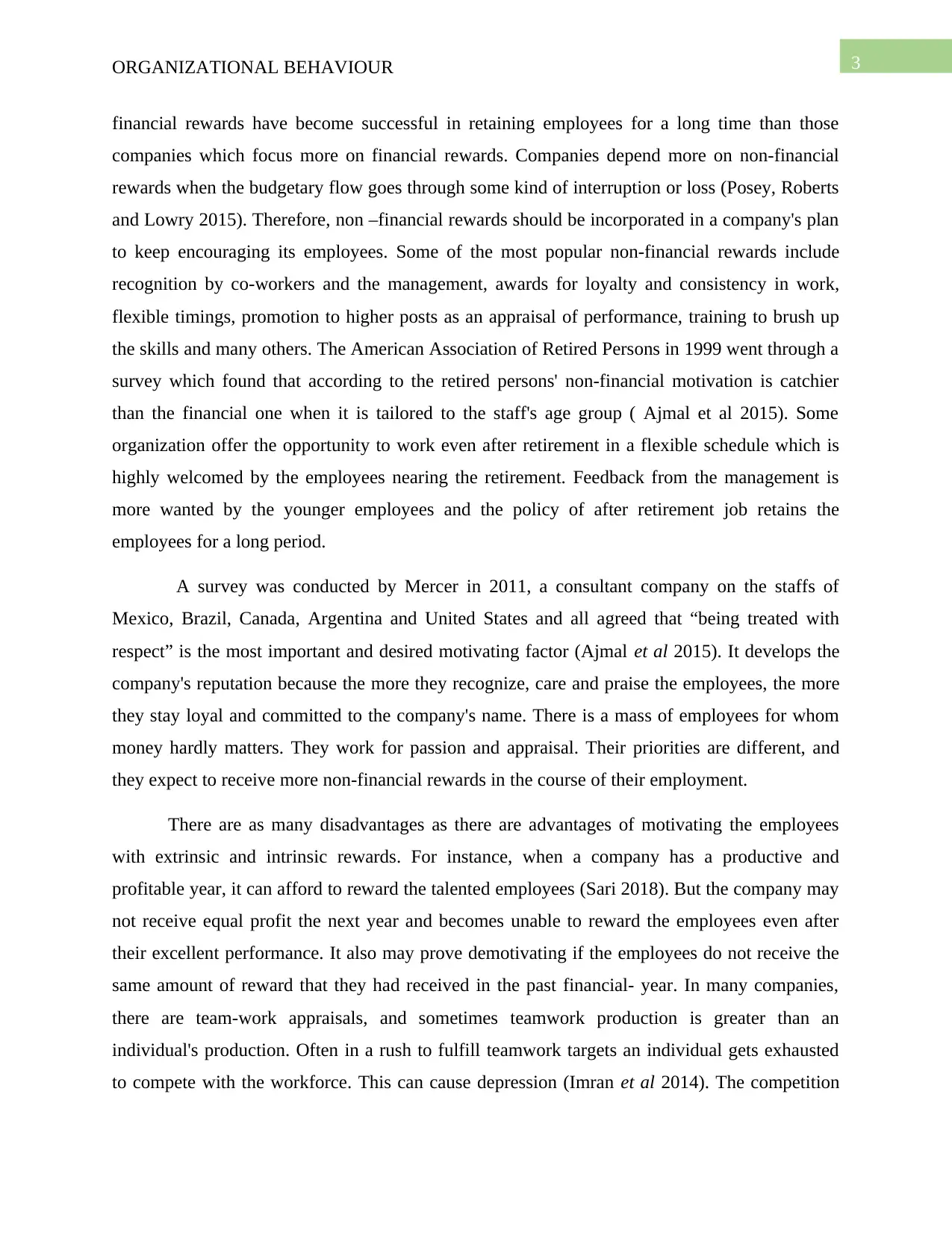
3ORGANIZATIONAL BEHAVIOUR
financial rewards have become successful in retaining employees for a long time than those
companies which focus more on financial rewards. Companies depend more on non-financial
rewards when the budgetary flow goes through some kind of interruption or loss (Posey, Roberts
and Lowry 2015). Therefore, non –financial rewards should be incorporated in a company's plan
to keep encouraging its employees. Some of the most popular non-financial rewards include
recognition by co-workers and the management, awards for loyalty and consistency in work,
flexible timings, promotion to higher posts as an appraisal of performance, training to brush up
the skills and many others. The American Association of Retired Persons in 1999 went through a
survey which found that according to the retired persons' non-financial motivation is catchier
than the financial one when it is tailored to the staff's age group ( Ajmal et al 2015). Some
organization offer the opportunity to work even after retirement in a flexible schedule which is
highly welcomed by the employees nearing the retirement. Feedback from the management is
more wanted by the younger employees and the policy of after retirement job retains the
employees for a long period.
A survey was conducted by Mercer in 2011, a consultant company on the staffs of
Mexico, Brazil, Canada, Argentina and United States and all agreed that “being treated with
respect” is the most important and desired motivating factor (Ajmal et al 2015). It develops the
company's reputation because the more they recognize, care and praise the employees, the more
they stay loyal and committed to the company's name. There is a mass of employees for whom
money hardly matters. They work for passion and appraisal. Their priorities are different, and
they expect to receive more non-financial rewards in the course of their employment.
There are as many disadvantages as there are advantages of motivating the employees
with extrinsic and intrinsic rewards. For instance, when a company has a productive and
profitable year, it can afford to reward the talented employees (Sari 2018). But the company may
not receive equal profit the next year and becomes unable to reward the employees even after
their excellent performance. It also may prove demotivating if the employees do not receive the
same amount of reward that they had received in the past financial- year. In many companies,
there are team-work appraisals, and sometimes teamwork production is greater than an
individual's production. Often in a rush to fulfill teamwork targets an individual gets exhausted
to compete with the workforce. This can cause depression (Imran et al 2014). The competition
financial rewards have become successful in retaining employees for a long time than those
companies which focus more on financial rewards. Companies depend more on non-financial
rewards when the budgetary flow goes through some kind of interruption or loss (Posey, Roberts
and Lowry 2015). Therefore, non –financial rewards should be incorporated in a company's plan
to keep encouraging its employees. Some of the most popular non-financial rewards include
recognition by co-workers and the management, awards for loyalty and consistency in work,
flexible timings, promotion to higher posts as an appraisal of performance, training to brush up
the skills and many others. The American Association of Retired Persons in 1999 went through a
survey which found that according to the retired persons' non-financial motivation is catchier
than the financial one when it is tailored to the staff's age group ( Ajmal et al 2015). Some
organization offer the opportunity to work even after retirement in a flexible schedule which is
highly welcomed by the employees nearing the retirement. Feedback from the management is
more wanted by the younger employees and the policy of after retirement job retains the
employees for a long period.
A survey was conducted by Mercer in 2011, a consultant company on the staffs of
Mexico, Brazil, Canada, Argentina and United States and all agreed that “being treated with
respect” is the most important and desired motivating factor (Ajmal et al 2015). It develops the
company's reputation because the more they recognize, care and praise the employees, the more
they stay loyal and committed to the company's name. There is a mass of employees for whom
money hardly matters. They work for passion and appraisal. Their priorities are different, and
they expect to receive more non-financial rewards in the course of their employment.
There are as many disadvantages as there are advantages of motivating the employees
with extrinsic and intrinsic rewards. For instance, when a company has a productive and
profitable year, it can afford to reward the talented employees (Sari 2018). But the company may
not receive equal profit the next year and becomes unable to reward the employees even after
their excellent performance. It also may prove demotivating if the employees do not receive the
same amount of reward that they had received in the past financial- year. In many companies,
there are team-work appraisals, and sometimes teamwork production is greater than an
individual's production. Often in a rush to fulfill teamwork targets an individual gets exhausted
to compete with the workforce. This can cause depression (Imran et al 2014). The competition
Secure Best Marks with AI Grader
Need help grading? Try our AI Grader for instant feedback on your assignments.

4ORGANIZATIONAL BEHAVIOUR
for bonus and all disrupts the workplace relationship between the co-workers. Instead of helping
each other they tend to overtake each other which violates the peace within the office. Burnouts
are another drawback of financial rewards. Bonus sometimes depends on the count of overtimes
a person does. The employees try hard to work for long days and nights to achieve bonus which
can prove harmful for the employee and the employer as well (Popov 2017). Low morals, less
productivity are among the first problems caused by overwork. It can affect the customer
relations too. Many companies provide incentives by sales an employee has done. The result is
the employee strives hard to make the maximum sales to receive a bonus. The customers get
exhausted from the employees push them hard to buy the product. If the person who is receiving
the gift or reward (non-financial) does not understand the value of the reward, it can be
disappointing for the employee. Therefore, the management should check whether the person can
evaluate the worth of the appraisal or gift. The management should observe the different
personalities of the team and encourage with a reward suitable to them.
Therefore, it can be concluded that in every organization, motivation is significantly
essential for the productivity of the company and the management, and the team leaders have a
remarkable role to play to keep the employees motivated. There are two types of motivation to
get the best out of the employees: financial and non-financial. The different employees in a
company have their expectations, but it is the responsibility of the management to develop and
combine with the theories suitable to bring them job satisfaction. There is no fixed theory to be
used, but an organization can apply a ‘mix' theory on the staffs. The employees should be given a
single platform to express their feedbacks and concerns so that the management could focus on
them. Disadvantages go side by side with the advantages of rewarding an employee in financial
and non-financial ways. Sometimes favors provided to the employees in the form of non-
financial rewards may cause a loss for the company itself. The work from home facility can slow
down the speed of the work since the home is always a comfortable and relaxing place. The
employee may take advantage of the facilities. Summing up a company is run by its employees.
They are the foundations of any organization. If they stay motivated, the company will see
development, and if they do not, the company will face a wide range of employee turnovers.
Hence, there are pros as well as cons, but the responsibility is completely on the shoulders of the
management to balance the two, to establish the company in world order.
for bonus and all disrupts the workplace relationship between the co-workers. Instead of helping
each other they tend to overtake each other which violates the peace within the office. Burnouts
are another drawback of financial rewards. Bonus sometimes depends on the count of overtimes
a person does. The employees try hard to work for long days and nights to achieve bonus which
can prove harmful for the employee and the employer as well (Popov 2017). Low morals, less
productivity are among the first problems caused by overwork. It can affect the customer
relations too. Many companies provide incentives by sales an employee has done. The result is
the employee strives hard to make the maximum sales to receive a bonus. The customers get
exhausted from the employees push them hard to buy the product. If the person who is receiving
the gift or reward (non-financial) does not understand the value of the reward, it can be
disappointing for the employee. Therefore, the management should check whether the person can
evaluate the worth of the appraisal or gift. The management should observe the different
personalities of the team and encourage with a reward suitable to them.
Therefore, it can be concluded that in every organization, motivation is significantly
essential for the productivity of the company and the management, and the team leaders have a
remarkable role to play to keep the employees motivated. There are two types of motivation to
get the best out of the employees: financial and non-financial. The different employees in a
company have their expectations, but it is the responsibility of the management to develop and
combine with the theories suitable to bring them job satisfaction. There is no fixed theory to be
used, but an organization can apply a ‘mix' theory on the staffs. The employees should be given a
single platform to express their feedbacks and concerns so that the management could focus on
them. Disadvantages go side by side with the advantages of rewarding an employee in financial
and non-financial ways. Sometimes favors provided to the employees in the form of non-
financial rewards may cause a loss for the company itself. The work from home facility can slow
down the speed of the work since the home is always a comfortable and relaxing place. The
employee may take advantage of the facilities. Summing up a company is run by its employees.
They are the foundations of any organization. If they stay motivated, the company will see
development, and if they do not, the company will face a wide range of employee turnovers.
Hence, there are pros as well as cons, but the responsibility is completely on the shoulders of the
management to balance the two, to establish the company in world order.
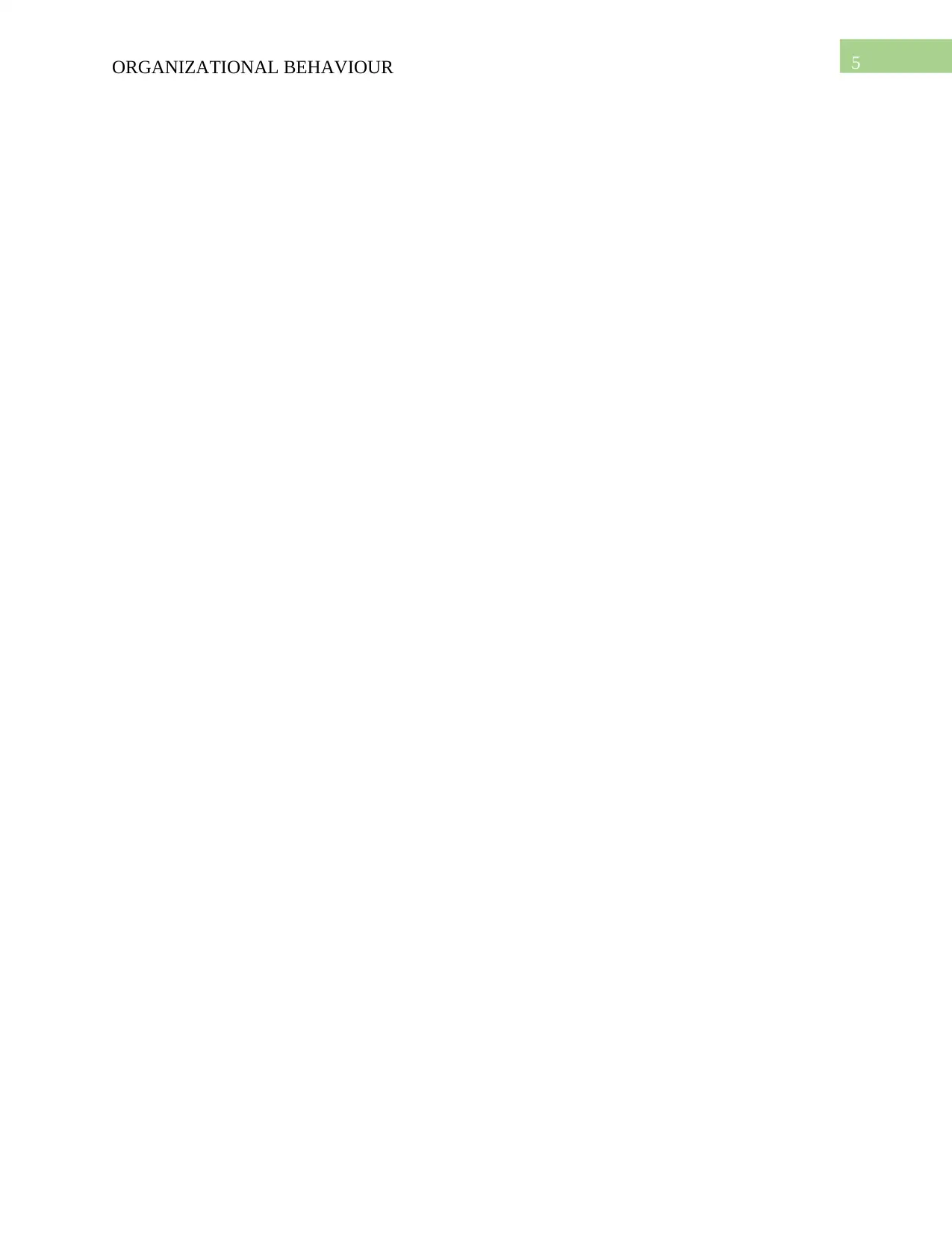
5ORGANIZATIONAL BEHAVIOUR
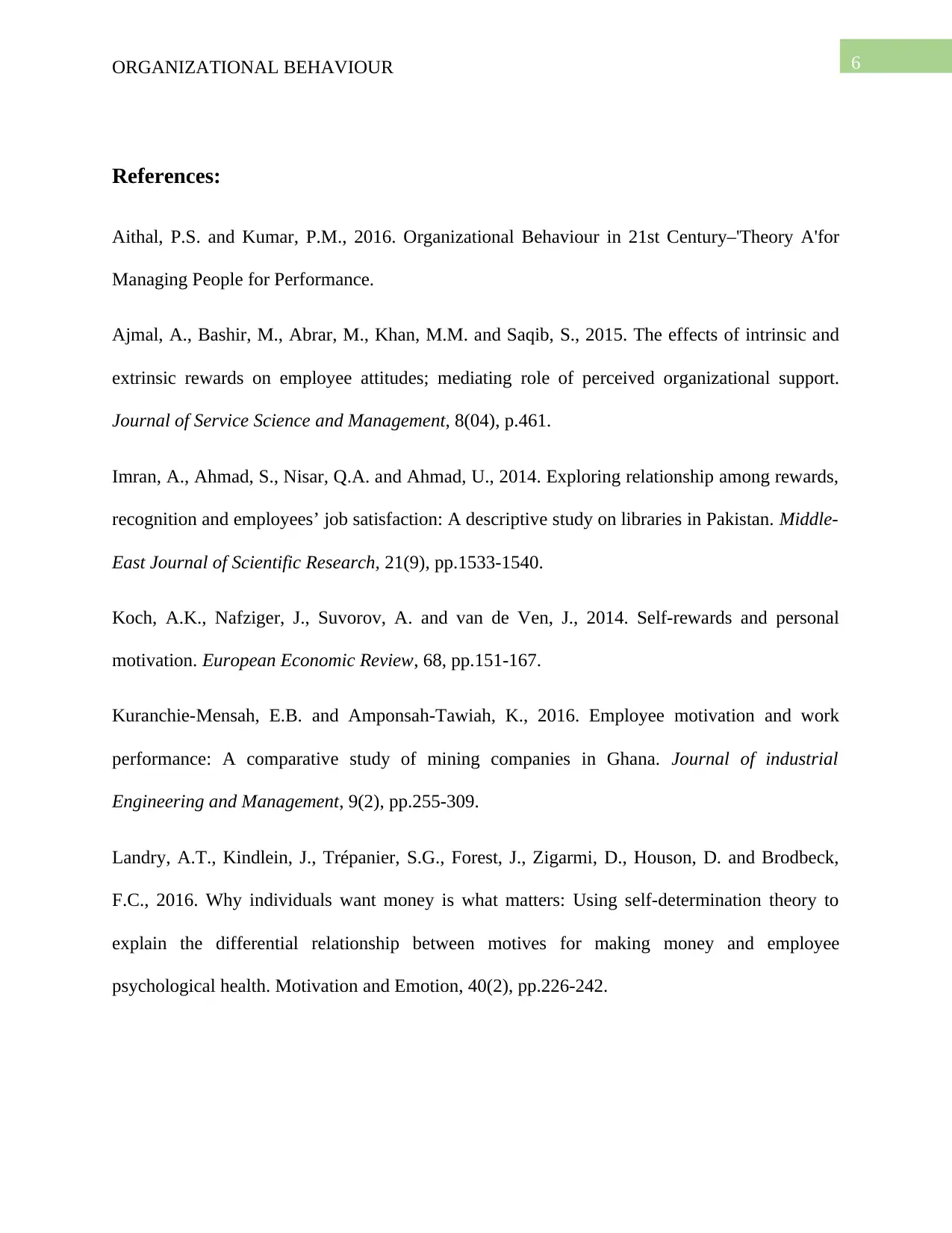
6ORGANIZATIONAL BEHAVIOUR
References:
Aithal, P.S. and Kumar, P.M., 2016. Organizational Behaviour in 21st Century–'Theory A'for
Managing People for Performance.
Ajmal, A., Bashir, M., Abrar, M., Khan, M.M. and Saqib, S., 2015. The effects of intrinsic and
extrinsic rewards on employee attitudes; mediating role of perceived organizational support.
Journal of Service Science and Management, 8(04), p.461.
Imran, A., Ahmad, S., Nisar, Q.A. and Ahmad, U., 2014. Exploring relationship among rewards,
recognition and employees’ job satisfaction: A descriptive study on libraries in Pakistan. Middle-
East Journal of Scientific Research, 21(9), pp.1533-1540.
Koch, A.K., Nafziger, J., Suvorov, A. and van de Ven, J., 2014. Self-rewards and personal
motivation. European Economic Review, 68, pp.151-167.
Kuranchie-Mensah, E.B. and Amponsah-Tawiah, K., 2016. Employee motivation and work
performance: A comparative study of mining companies in Ghana. Journal of industrial
Engineering and Management, 9(2), pp.255-309.
Landry, A.T., Kindlein, J., Trépanier, S.G., Forest, J., Zigarmi, D., Houson, D. and Brodbeck,
F.C., 2016. Why individuals want money is what matters: Using self-determination theory to
explain the differential relationship between motives for making money and employee
psychological health. Motivation and Emotion, 40(2), pp.226-242.
References:
Aithal, P.S. and Kumar, P.M., 2016. Organizational Behaviour in 21st Century–'Theory A'for
Managing People for Performance.
Ajmal, A., Bashir, M., Abrar, M., Khan, M.M. and Saqib, S., 2015. The effects of intrinsic and
extrinsic rewards on employee attitudes; mediating role of perceived organizational support.
Journal of Service Science and Management, 8(04), p.461.
Imran, A., Ahmad, S., Nisar, Q.A. and Ahmad, U., 2014. Exploring relationship among rewards,
recognition and employees’ job satisfaction: A descriptive study on libraries in Pakistan. Middle-
East Journal of Scientific Research, 21(9), pp.1533-1540.
Koch, A.K., Nafziger, J., Suvorov, A. and van de Ven, J., 2014. Self-rewards and personal
motivation. European Economic Review, 68, pp.151-167.
Kuranchie-Mensah, E.B. and Amponsah-Tawiah, K., 2016. Employee motivation and work
performance: A comparative study of mining companies in Ghana. Journal of industrial
Engineering and Management, 9(2), pp.255-309.
Landry, A.T., Kindlein, J., Trépanier, S.G., Forest, J., Zigarmi, D., Houson, D. and Brodbeck,
F.C., 2016. Why individuals want money is what matters: Using self-determination theory to
explain the differential relationship between motives for making money and employee
psychological health. Motivation and Emotion, 40(2), pp.226-242.
Paraphrase This Document
Need a fresh take? Get an instant paraphrase of this document with our AI Paraphraser

7ORGANIZATIONAL BEHAVIOUR
Mikkelsen, M.F., Jacobsen, C.B. and Andersen, L.B., 2017. Managing employee motivation:
Exploring the connections between managers’ enforcement actions, employee perceptions, and
employee intrinsic motivation. International Public Management Journal, 20(2), pp.183-205.
Nimri, M., Bdair, A. and Al Bitar, H., 2015. Applying the expectancy theory to explain the
motivation of public sector employees in Jordan. Middle East Journal of Business, 10(3), pp.70-
82.
Olafsen, A.H., Halvari, H., Forest, J. and Deci, E.L., 2015. Show them the money? The role of
pay, managerial need support, and justice in a self‐determination theory model of intrinsic work
motivation. Scandinavian journal of psychology, 56(4), pp.447-457.
Popov, A., 2017. Project of Implementation of Economic Value Added concept for Increasing
Financial Performance in the Selected Company.
Posey, C., Roberts, T.L. and Lowry, P.B., 2015. The impact of organizational commitment on
insiders’ motivation to protect organizational information assets. Journal of Management
Information Systems, 32(4), pp.179-214.
Sari, E.T., 2018. MOTIVATION AND SATISFACTION TOWARDS
EMPLOYEES’LOYALTY TO ACHIEVE COMPANY’S ADVANTAGE. JMBI UNSRAT
(Jurnal Ilmiah Manajemen Bisnis dan Inovasi Universitas Sam Ratulangi)., 4(1).
Mikkelsen, M.F., Jacobsen, C.B. and Andersen, L.B., 2017. Managing employee motivation:
Exploring the connections between managers’ enforcement actions, employee perceptions, and
employee intrinsic motivation. International Public Management Journal, 20(2), pp.183-205.
Nimri, M., Bdair, A. and Al Bitar, H., 2015. Applying the expectancy theory to explain the
motivation of public sector employees in Jordan. Middle East Journal of Business, 10(3), pp.70-
82.
Olafsen, A.H., Halvari, H., Forest, J. and Deci, E.L., 2015. Show them the money? The role of
pay, managerial need support, and justice in a self‐determination theory model of intrinsic work
motivation. Scandinavian journal of psychology, 56(4), pp.447-457.
Popov, A., 2017. Project of Implementation of Economic Value Added concept for Increasing
Financial Performance in the Selected Company.
Posey, C., Roberts, T.L. and Lowry, P.B., 2015. The impact of organizational commitment on
insiders’ motivation to protect organizational information assets. Journal of Management
Information Systems, 32(4), pp.179-214.
Sari, E.T., 2018. MOTIVATION AND SATISFACTION TOWARDS
EMPLOYEES’LOYALTY TO ACHIEVE COMPANY’S ADVANTAGE. JMBI UNSRAT
(Jurnal Ilmiah Manajemen Bisnis dan Inovasi Universitas Sam Ratulangi)., 4(1).
1 out of 8
Related Documents
Your All-in-One AI-Powered Toolkit for Academic Success.
+13062052269
info@desklib.com
Available 24*7 on WhatsApp / Email
![[object Object]](/_next/static/media/star-bottom.7253800d.svg)
Unlock your academic potential
© 2024 | Zucol Services PVT LTD | All rights reserved.





